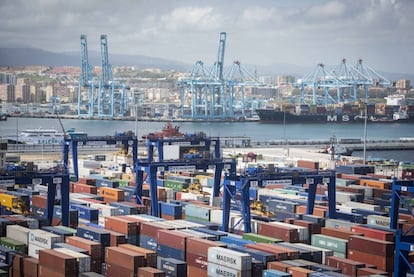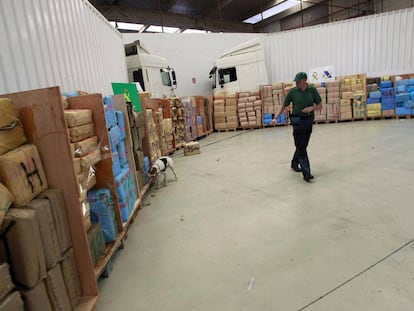Spain: Europe’s new cocaine gateway
A record-breaking amount of the illicit drug is arriving in Spanish port cities such as Algeciras and Valencia

The confrontational attitude of the drug gangs that traffic hashish in La Línea de la Concepción, in the south of Spain, has dominated news headlines and political agendas after a recent spate of drug-related violence plunged the Campo de Gibraltar area into crisis.
It is an avalanche. We have never seen anything like this
GRECO officer
But just 20 kilometers from Gibraltar, in the port city of Algeciras, huge amounts of cocaine are discreetly entering into Spain. With the media’s attention focused on Gibraltar, Algeciras has become one of the main entry points for the narcotic into the rest of Europe.
Among the four million containers that arrive every year at the port, thousands of kilos of cocaine, mostly from Colombia, are camouflaged between bananas, frozen chickens, or simply stuffed in backpacks.
According to the latest report from the United Nations Office on Drug and Crime (UNODC), published just days ago, the circulation of cocaine is higher than ever. And they have the data to prove it. The amount of cocaine seized in 2016 (the latest year with available data) was over 1,000 tons – an unprecedented figure. And the number of hectares used to grow coca has smashed all the records. Cocaine trafficking, the UN warns, has reached epidemic proportions.
“It is an avalanche, massive amounts are coming in,” says an officer from the Special Response Team against Organized Crime (GRECO) of Spain’s National Police. “We have never seen anything like this.”

On the other side of the law, a veteran drug trafficker from the northwestern region of Galicia agrees that the problem has reached a new dimension. “There’s too much of it. There’s more cocaine than is needed. There are warehouses right now in Madrid and Seville where it’s piling up,” he says, sipping a coffee at a sidewalk café in Vigo. This drug trafficker complains that the skyrocketing supply is hurting prices. “Prices have hit rock bottom. A kilogram has always gone for €32,000 to €35,000, but now it is being sold for €27,000 and €28,000.” As well as Algeciras, other Spanish ports along the Mediterranean Sea (especially Valencia and Barcelona) and along the coast of Galicia – a traditional cocaine stronghold – have become a gateway for cocaine.
Most of the drug comes from Colombia, where 68% of the world’s coca crops are located. There is overproduction, due in part to the peace agreement between the Colombian government and the Revolutionary Armed Forces of Colombia (FARC). As FARC members have demobilized, new drug gangs have rushed to fill the void and now control thousands of hectares of land. Unlike Colombia’s former attention-grabbing narco groups, these gangs have decided to avoid the spotlight and focus on production. If there used to be two or three harvests a year, now there are up to six. And the collapse of Colombia’s border with Venezuela due to the political crisis has allowed the drug to exit the country without any problems.
They have entire rooms with stacks of money that reach the roof
GRECO Galicia officer
“There’s also been a change in criminal structures,” adds Ignacio de Lucas, an anti-drug prosecutor at Spain’s High Court, the Audiencia Nacional. “They don’t have such strict hierarchies as before. They’re not mafias but rather a kind of franchise with more flexible and dynamic structures, with people who come and go, and this has made it very difficult to charge them as a criminal organization.”
For years, Europe has been the favorite destination. The United Kingdom is the third-largest consumer of cocaine in the world (2.3% of the population consumes the drug) followed by Spain (2% of people are consumers). Spain, however, has become one of the main cocaine gateways into Europe, comparable only to The Netherlands, with the drug typically moved through port cities.
According to Javier Cortés, the head of Valencia’s Customs Surveillance Service (SVA), the port of Valencia “receives more than five million containers a year. It’s utopian to think we could check them all. But we try.” Prosecutor De Lucas goes further: “The big ports – be it Valencia, Antwerp or Rotterdam – are black holes.”
Cortés explains that ship containers transport sports bags with cocaine that are picked up in Spanish ports by bands known as “rescuers.” These rescuers open the containers, swap the bags for new ones and take away the drugs. They charge €1,000 for every kilo that is rescued and normally collect between 100 and 300 kilos.
“We need to pay more attention to businesses – almost always from Latin America – that are specifically created to import cocaine,” says the SVA officer, referring to the fruit and fish businesses that use legal commercial channels to import the drugs. The FARC, for instance, set up dozens of these legal businesses, some of which have had great commercial success in Europe. Targeting their trade channels is difficult though because, at first sight, they are legal enterprises.
To expose these black holes, De Lucas and other Spanish prosecutors have joined the Iberian-American Network of Prosecutors Against Drug Trafficking. “We all know that we are never going to win the fight against drug trafficking,” admits De Lucas. “So we have to prioritize. Either we go after the small-time drug dealer on the corner or we go after the big organizations. Not Spain nor any other country has the resources to do everything.”
Galicia, another hotspot
Galicia continues to be one of Spain’s major drug strongholds with most of the cocaine entering the region via speedboats. “Few drugs come here via ship containers. We continue to use speedboats,” says the veteran drug trafficker from Galicia. “We’re sea people. And the Colombians want us to do it this way. They send a fishing boat or a freight ship with the merchandise, we cross half the ocean on speedboats and bring the packages back to land.”
Today Galicia is controlled by four main drug lords. They decide how much cocaine enters and how, in an alliance with Colombian gangs that they have maintained for decades. They try to be discreet. Some play the role of the successful businessman while others have never left their coastal villages.
Spain is the fourth-largest consumer of cocaine in the world
“They don’t know what to do with the money. They don’t want to launder it in case they are caught, so they have entire rooms with stacks of money that reach the roof,” says a member of GRECO Galicia. “Cocaine trafficking may be invisible but it continues here. And the people who control it are very clever.”
He explains: “They are entrepreneurs with constant projects. Some work out well and others don’t, but they don’t stop. Until you completely dismantle the entire network, they won’t stop.”
The GRECO official says part of the problem is that police often choose to investigate local cases to get “fast results and easy convictions” and avoid more complex investigations that require time and resources. “We can’t address the problem this way,” he says.
Going after a drug trafficker’s assets can cause a lot of damage, say the prosecutors Ana Villagómez and Macarena Arroyo, but according to De Lucas the number of legal cases against drug traffickers dropped last year and only 8% were related to money laundering.
A police officer from the Anti-Narcotics Force explains how the drug trade works. “The cocaine belongs to the Colombians. They bring it to Europe and it is introduced into Spain. Then the merchandise is passed on to the buyers.”
According to the National Police, these buyers are powerful Dutch drug traffickers of Moroccan origin who are based in Andalusia. “They are the most dangerous and powerful. They moved away from hashish and now discreetly focus on cocaine.” They work with Kosovar-Albanian gangs based in Valencia and Serbian mafias in Barcelona, who buy the cocaine and distribute it across Europe. “These are the people we will be fighting in the future.”
English version by Melissa Kitson.
Tu suscripción se está usando en otro dispositivo
¿Quieres añadir otro usuario a tu suscripción?
Si continúas leyendo en este dispositivo, no se podrá leer en el otro.
FlechaTu suscripción se está usando en otro dispositivo y solo puedes acceder a EL PAÍS desde un dispositivo a la vez.
Si quieres compartir tu cuenta, cambia tu suscripción a la modalidad Premium, así podrás añadir otro usuario. Cada uno accederá con su propia cuenta de email, lo que os permitirá personalizar vuestra experiencia en EL PAÍS.
¿Tienes una suscripción de empresa? Accede aquí para contratar más cuentas.
En el caso de no saber quién está usando tu cuenta, te recomendamos cambiar tu contraseña aquí.
Si decides continuar compartiendo tu cuenta, este mensaje se mostrará en tu dispositivo y en el de la otra persona que está usando tu cuenta de forma indefinida, afectando a tu experiencia de lectura. Puedes consultar aquí los términos y condiciones de la suscripción digital.
More information
Archived In
Últimas noticias
Maduro pleads not guilty before the federal court in New York: ‘I am still the president of Venezuela’
A new test can detect Alzheimer’s from a finger prick
UN team enters Sudanese city of El Fasher after paramilitary massacre: ‘It’s like a ghost town’
A recipe for resistance: Indigenous peoples politicize their struggles from the kitchen
Most viewed
- Gilles Lipovetsky: ‘If you want to live better and fall in love, take Prozac, don’t look to philosophy’
- Alain Aspect, Nobel laureate in physics: ‘Einstein was so smart that he would have had to recognize quantum entanglement’
- Alvin Hellerstein, a 92-year-old judge appointed by Bill Clinton, to preside over Maduro’s trial in New York
- Maduro’s downfall puts China’s relationship with Venezuela to the test
- Why oil has been at the center of Venezuela-US conflicts for decades










































